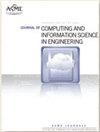利用多领域知识进行以用户为中心的产品概念设计
IF 3.3
3区 工程技术
Q2 COMPUTER SCIENCE, INTERDISCIPLINARY APPLICATIONS
Journal of Computing and Information Science in Engineering
Pub Date : 2023-05-03
DOI:10.1115/1.4062456
引用次数: 1
摘要
概念设计是根据用户需求部署产品功能和结构并最终产生概念设计解决方案的设计阶段。产品的日益多样化导致了用户深度参与的定制设计的推广。因此,人们越来越关注以用户为中心的概念设计。在这方面,用户、设计师和设计方案之间的关系已经发生了微妙的变化,这给传统的以设计师为导向的设计模式带来了挑战。为了解决更深层次的用户参与所带来的复杂理解和决策问题,需要讨论以用户为中心的新产品概念设计模型。在新的设计模型中,通过解决方案的设计来解决用户不断变化或增长的需求,并利用多学科知识来指导概念设计过程是重点关注的关键领域。为了进一步描述这个设计模型,本文考察了用户、设计师、设计方案和多领域知识之间以用户为中心的互连。为了优化设计方案,基于设计偏差的方案解析过程和知识映射被认为是有效的方法。此外,本文还介绍了设计偏差的类型和多领域知识支持技术。本文章由计算机程序翻译,如有差异,请以英文原文为准。
Harnessing Multi-Domain Knowledge for User-Centric Product Conceptual Design
Conceptual design is the design phase that deploys product functions and structures based on user requirements and ultimately generates conceptual design solutions. The increasing diversification of products has led to the promotion of customized design that involves deep user participation. As a result, there has been a growing focus on user-centric conceptual design. In this regard, the relationship among users, designers, and design solutions has been subtly changed, which has brought challenges to the traditional designer-oriented design model. To address the complex understanding and decision-making problem caused by deeper user participation, emerging new user-centric product conceptual design models need to be discussed. In the new design model, addressing the changing or growing requirements of users through the design of solutions and leveraging multidisciplinary knowledge to guide the conceptual design process are the critical areas of focus. To further describe this design model, this paper examines the user-centric interconnection among users, designers, design solutions, and multi-domain knowledge. In order to optimize design solutions, the solution resolution process and knowledge mapping based on design deviations are considered effective approaches. In addition, the paper also presents the types of design deviations and the multi-domain knowledge support techniques.
求助全文
通过发布文献求助,成功后即可免费获取论文全文。
去求助
来源期刊
CiteScore
6.30
自引率
12.90%
发文量
100
审稿时长
6 months
期刊介绍:
The ASME Journal of Computing and Information Science in Engineering (JCISE) publishes articles related to Algorithms, Computational Methods, Computing Infrastructure, Computer-Interpretable Representations, Human-Computer Interfaces, Information Science, and/or System Architectures that aim to improve some aspect of product and system lifecycle (e.g., design, manufacturing, operation, maintenance, disposal, recycling etc.). Applications considered in JCISE manuscripts should be relevant to the mechanical engineering discipline. Papers can be focused on fundamental research leading to new methods, or adaptation of existing methods for new applications.
Scope: Advanced Computing Infrastructure; Artificial Intelligence; Big Data and Analytics; Collaborative Design; Computer Aided Design; Computer Aided Engineering; Computer Aided Manufacturing; Computational Foundations for Additive Manufacturing; Computational Foundations for Engineering Optimization; Computational Geometry; Computational Metrology; Computational Synthesis; Conceptual Design; Cybermanufacturing; Cyber Physical Security for Factories; Cyber Physical System Design and Operation; Data-Driven Engineering Applications; Engineering Informatics; Geometric Reasoning; GPU Computing for Design and Manufacturing; Human Computer Interfaces/Interactions; Industrial Internet of Things; Knowledge Engineering; Information Management; Inverse Methods for Engineering Applications; Machine Learning for Engineering Applications; Manufacturing Planning; Manufacturing Automation; Model-based Systems Engineering; Multiphysics Modeling and Simulation; Multiscale Modeling and Simulation; Multidisciplinary Optimization; Physics-Based Simulations; Process Modeling for Engineering Applications; Qualification, Verification and Validation of Computational Models; Symbolic Computing for Engineering Applications; Tolerance Modeling; Topology and Shape Optimization; Virtual and Augmented Reality Environments; Virtual Prototyping

 求助内容:
求助内容: 应助结果提醒方式:
应助结果提醒方式:


